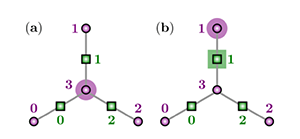Volume 107, Issues 9 - 10 May 2023 | |
Advertisement  | The American Physical Society (APS), publisher of the Physical Review journals, is joining more than 20,000 individuals and organizations across 160 countries in a commitment to improve how researchers and their contributions to the scientific record are evaluated. APS is proud to mark the 10th anniversary of the Declaration on Research Assessment (DORA) by officially signing on to the international initiative. Learn more. | | | | | | Advertisement | APS would like to learn about your publishing experiences with scientific journals, including PRL and other Physical Review journals. Please complete this survey to help APS better understand and meet your publishing needs. Take the survey. | | | | | | Not an APS member? Join today to start connecting with a community of more than 50,000 physicists. | | | | Editors' Suggestion Alexei Bazavov, Carleton DeTar, Aida X. El-Khadra, Elvira Gámiz, Zechariah Gelzer, Steven Gottlieb, William I. Jay, Hwancheol Jeong, Andreas S. Kronfeld, Ruizi Li, Andrew T. Lytle, Paul B. Mackenzie, Ethan T. Neil, Thomas Primer, James N. Simone, Robert L. Sugar, Doug Toussaint, Ruth S. Van de Water, and Alejandro Vaquero (Fermilab Lattice and MILC Collaborations) Phys. Rev. D 107, 094516 (2023) – Published 31 May 2023  | New theoretical results give a stringent test of Standard Model and second-row CKM unitarity. Precise calculations using lattice QCD yield percent-level determinations of the CKM matrix elements |Vcd| and |Vcs| from the semileptonic decays D→πℓν and D→Kℓν, respectively, as well as the world's first extraction of |Vcd| from the decay Ds→Kℓν. | | | | | | Editors' Suggestion Melissa Diamond, Damiano F. G. Fiorillo, Gustavo Marques-Tavares, and Edoardo Vitagliano Phys. Rev. D 107, 103029 (2023) – Published 18 May 2023  | This study revisits bounds on axion-like particles (ALPs) derived from supernovae, where they may be generated in stellar interiors before decaying to photons. Past works have used observations from SN1987A to exclude ALP masses of 10s of MeV, due to the absence of a signal in the Gamma Ray Spectrometer aboard the Solar Maximum Mission satellite. The present paper argues that such particles would generate a fireball of plasma around the supernova, ultimately leading to a much lower energy photon signal, thus invalidating the old bounds in this scenario. However, the authors find that data from the Pioneer Venus Orbiter can be used to set similar limits. | | | | | | Editors' Suggestion Jakob Ehring, Sajad Abbar, Hans-Thomas Janka, Georg Raffelt, and Irene Tamborra Phys. Rev. D 107, 103034 (2023) – Published 22 May 2023  | Neutrino fast flavor conversion (FFC) typically occurs in extremely dense neutrino environments such as those of core-collapse supernovae (CCNe). The typical distance and time scales at which FFCs take place are much smaller than those accessible to hydrodynamic simulations of CCSNe. In this paper, FFCs are schematically taken into account in spherically symmetric CCSN hydrodynamic simulations and their distinctive effects are delineated. | | | | | | Editors' Suggestion D. Ehlert, F. Oikonomou, and M. Unger Phys. Rev. D 107, 103045 (2023) – Published 24 May 2023  | Models of sources of ultra high energy cosmic rays (UHECR)s usually assume that these sources, despite significant variability between them, accelerate particles to the same maximum energy. Here, the authors improve on this assumption by assigning their array of sources a broken-power-law distribution of the maximum energies. They observe that a power law distribution necessitates that the source to source variation be small. | | | | | | Editors' Suggestion Jacques Distler, Grant Elliot, Monica Jinwoo Kang, and Craig Lawrie Phys. Rev. D 107, 106005 (2023) – Published 3 May 2023  | A common way to construct 4D superconformal field theories (SCFTs) is to compactify the N=(2,0) 6D SCFT on a Riemann surface with a variety of punctures. One question that arises is, when are the 4D SCFTs obtained from distinct constructions isomorphic? The authors show in great detail and with a large class of examples that this happens when there exists a "parent" N=(1,0) 6D SCFT. However, there are also some "oddball" candidates of isomorphic theories without a six-dimensional origin. | | | | | | Editors' Suggestion Letter Matthew Reece, Lian-Tao Wang, and Zhong-Zhi Xianyu Phys. Rev. D 107, L101304 (2023) – Published 23 May 2023  | The authors study the signature of heavy spectator fields ("cosmological collider signal") that couple to the inflaton for the case of large-field inflation with order MPlank excursion of the inflaton. Motivated by the so-called swampland distance conjecture, they consider exponentially time-dependent masses and show that the resulting scale dependence of the bispectrum can be an informative probe for general properties of different classes of inflation. | | | | | | | |



No comments:
Post a Comment